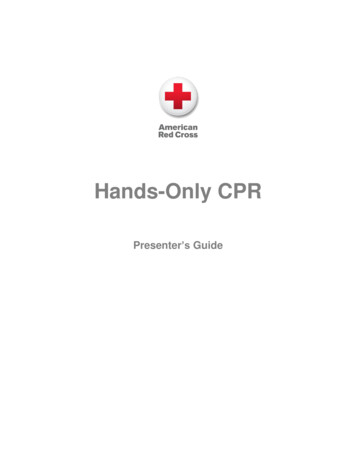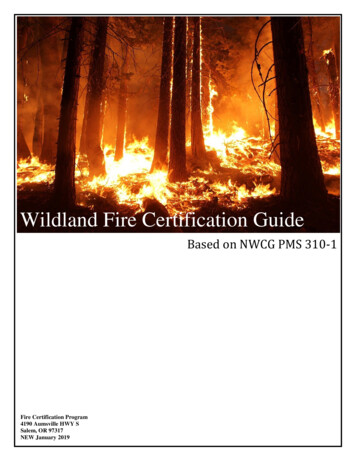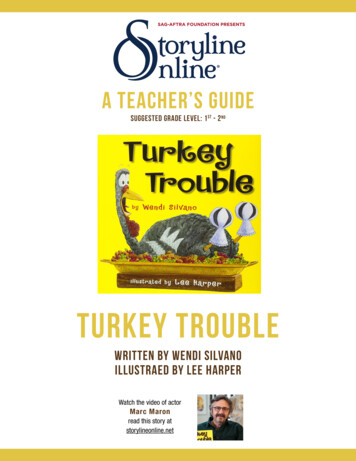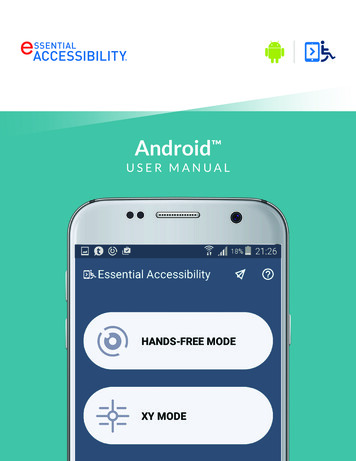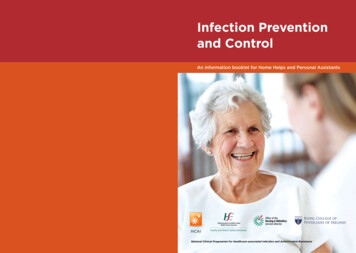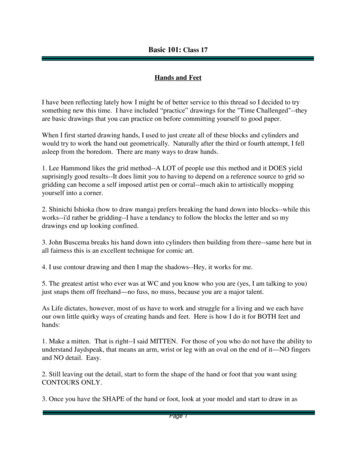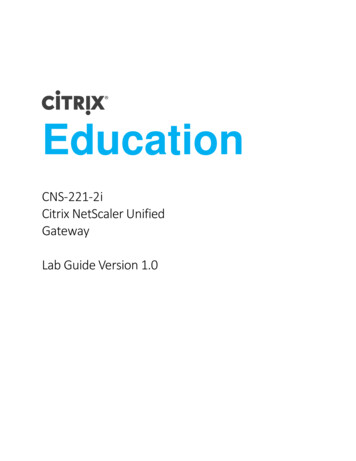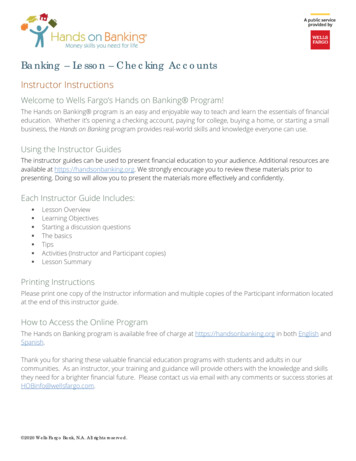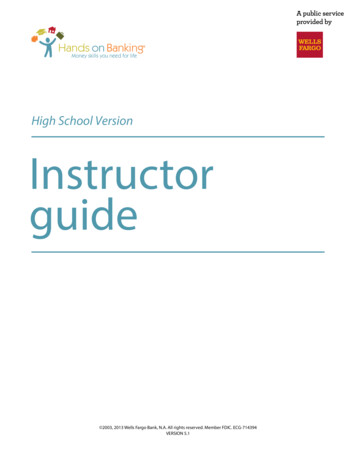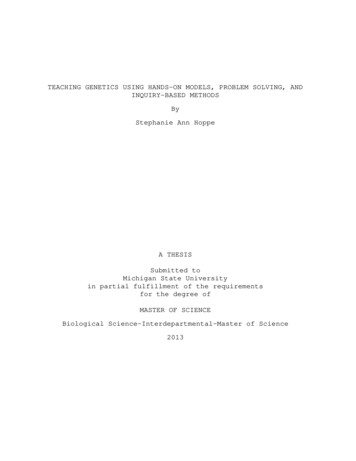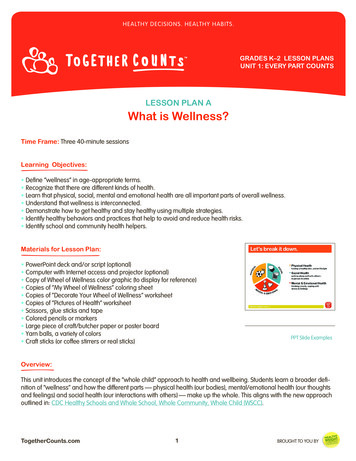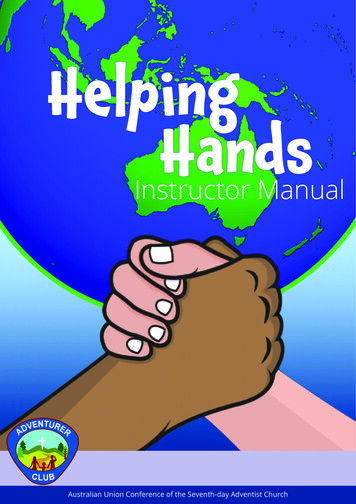
Transcription
Helping HandsINSTRUCTOR MANUALHelpingHandsInstructor ManualVENTURERADCLUBHelping Hands Instructor Manual PageAustralian Union Conference of the Seventh-day Adventist Church1
Helping HandsINSTRUCTOR MANUALAdapted, with permission, from the General Conference Instructor Manual by theAustralian Union Conference.Australian contact: adventurer@adventist.org.auProduced by:General Conference Youth Ministries Department12501 Old Columbia PikeSilver Spring, MD 20904Departmental Director: Gary BlanchardAssociate Youth Director: Pako MokgwaneAssociate Youth Director: Andrés J. PeraltaEditor-in-Chief: Andrés J. PeraltaDepartmental Advisor: Abner De Los SantosSenior Editorial Assistant: Kenia Reyes-de LeónProject Manager: Mark O’FfillContent Contributors: Mark O’FfillTed & Betsy BurgdorffCopy Editor: Mark O’FfillCover & Interior Designer:Jonatan TejelIsaac ChiaAdrian Gutierrez PerezWilbert Hilario (ClicArt)Had Graphic Inc.hadgraphic@gmail.comPhotos by: ShutterstockDivision Correspondents:Al Powell (IAD)Alastair Agbaje (TED)Armando Miranda (NAD)Benoy Tirkey (SUD)Busi Khumalo (SID)Carlos Campitelli (SAD)Gennady Kasap (ESD)Ron Genebago (SSD)Jonatan Tejel (EUD)Magulilo Mwakalonge (ECD)Nak Hyung Kim (NSD)Nick Kross (SPD)Peter Bo Bohsen (TED)Tihomir Lazic (TED)Tracy Wood (NAD)Udolcy Zukowski (SAD)Ugochukwu Elems (WAD)Vandeon Griffin (NAD)Zlatko Musija (TED)Resources:Gomez, Ada. “Adventist Adventurer Awards.” Adventist AdventurerAwards - Wikibooks.org. North American Division Club Ministries,2014. Web. 26 July 2017.Gooch, Jennifer A. Eager Beaver Leader’s Guide with 23 ThemedMeeting Plans. 3rd ed. Lincoln, Neb.: AdventSource, 2007, 2015.Print.For informationWebsite: youth.adventist.orgMailing Address:Adventist Youth MinistriesGeneral Conference of Seventh-day Adventist12501 Old Columbia Pike,Silver Spring, MD 20904-6600, USAHelping Hands Instructor Manual Page2
Helping HandsINSTRUCTOR MANUALWelcome 4Adventurer Club History 6Introduction to Helping Hands 8Helping Hands Checklist 9Section 1 - Helping Hands Level10Adventurer LogoAdventurer Pledge / LawAdventurer SongHelping Hands GoalsHelping Hands CurriculumAdventurer AwardsSection 2 - Characteristics of the Helping Hands15What you need to knowPhysical CharacteristicsCognitive CharacteristicsSocial CharacteristicsSpiritual CharacteristicsDo’s and Don’ts of DisciplinesSection 3 - Helping Hands and Disabilities22Including Helping Hands with Special NeedsPlanning Inclusive ActivitiesSection 4 - Helping Hands Learning and Playing25MeetingsActivity TipsHelping Hands Instructor Manual Page3
Helping HandsINSTRUCTOR MANUALWelcomeThank you for being a part of our newly released Adventurer Curriculum. Wehave remastered, re-engineered, and at times started over to make sure thatthis new curriculum is fun, uplifting, appropriate for each age level, and mostimportantly, Jesus-centred. We wanted to build a curriculum that can be donewith a small group, large group, family and children, Children’s ministry group,even Bible School group!We have used several criteria in building this curricula. We worked with Adventisteducators and youth leaders to make sure we had the best resources availablefor our Adventurers. First, we have used Bloom’s taxonomy, a broad rangingmethodology especially appropriate for 7 year olds and up, that help us ask thechildren to do things that they are truly developmentally capable of doing. Forexample, we ask Little Lambs to listen to a story, while we ask 8 and 9 year olds toread age-appropriate stories.In addition, we have used a multi-modal learning philosophy, meaning that werealise that Adventurers learn in different ways. Thus, we have requirements thatappeal to children who learn best through listening, playing, drawing, singing,organising, moving, and so-on. We also filtered our requirements throughdevelopmental filters. Spiritual stages of development (originally developed byDr. James W. Fowler), have been well explained and demonstrated in YouthMinistry by Adventist Youth Innovator Steve Case of Involve Youth.AdventurersEach lesson is meant to be mostly hands-on. That means most of the time youwill be actively doing something to learn about the topic. Sometimes, you willhave to take notes, or tick a box (to remember what you did), but most of thetime you will be jumping, running, crafting, drawing, exercising, singing, praying, orreading something!In many cases, your adult caregivers, whether they be parents, grandparents,guardians, or favourite neighbour, can help you accomplish the “jobs”. Help themfeel involved and be sure to always say thank you!ParentsWe value the time you have invested in Adventurers. Many of you are doublingas leaders for Adventurers. We thank you. We have created a curricula that issafe yet adventurous, varied, but specific in its Christ-centred goal. We hope thechildren will bring home new found truths they can put into action about “My Self,My God, My Family, and My World”.Helping Hands Instructor Manual Page4
Helping HandsINSTRUCTOR MANUALPlease have your Adventurer share their experiences with you by showing you thepages they worked through (and the games/stories they learned along the way).Know that a lot of it is experiential so they won’t write a lot. They will insteadexperience a great deal.LeadersIn this Instructor Manual you will find a variety of ‘big picture’ helps to guide youas you create a safe environment for your group of Adventurers. Developmentalstages, working with special needs children in your unit, and much more isincluded here. We have tried to think of things that can be done with fewresources, limited spaces, and limited budget. However, your club is differentfrom any other, so please feel free to adapt the ideas to meet the needs of yourgroup.There are a total of six years worth of curriculum, each one age appropriate.The first, Little Lamb is for 4 year olds, the second, Early Bird, for 5 year olds,Busy Bee, for 6 year olds, Sunbeam, for 7 year olds, Builder, for 8 year olds, andHelping Hands, for 9 year olds. Many kids will turn from one age to the next whileworking on the curriculum, but should work to complete it before starting thenext class. Patches (called Awards) and pins are available for order through theAdventist Book Centre (ABC) BeeEarlyBird4YeBuilderSunbeam86Years OldYe5Years Oldars OldHelpingHandsYe7ars Oldars Old9Years OldThanks for joining us in the journey!Andrés J. PeraltaAssociate Youth DirectorHelping Hands Instructor Manual Page5
Helping HandsINSTRUCTOR MANUALAdventurer Club HistoryThe history of Adventurers started back in 1917 when the Primary ReadingCourse was introduced. This certificate eventually became part of the classrequirements. In 1924 the Sunbeam class was taught in a second-gradeclassroom and a pin was awarded for completing the requirements. The awardingof the Busy Bee pin first appeared in 1928 as part of the commencementexercises at school, and by 1929 the term “Investiture Service” was used todescribe the event where they awarded certificates and pins. The Busy BeePledge and Law also first appeared in 1929.The names used for this age group have varied over time and location andincluded Preparatory classes, Pre-Juniors, Pre-Friends, Pre-JMV, Pre-AJY, PrePathfinders, Achievement classes, and Adventurers.By 1933, this group was known as “Preparatory Members”. The two predominantclasses taught on the West Coast of the United States were Busy Bee and HelpingHands, while to the East they were known as Sunbeam and Builder. All of theseclasses used the same Pledge and Law, with only slight differences in the otherrequirements.By 1938 the term “Progressive Class Work” was used when referring to all theclasses from Busy Bee up to Master Comrade.In 1940 the General Conference outlined two Missionary Volunteer ProgressiveClasses that were below the Friend class. They were Sunbeam and Builder. Theyhad simple celluloid pins, and where neckerchiefs were desired, tan was used forthe Sunbeams and jade green for the Builders.Because of so many other names being used for these classes, both in the U.S.and overseas, such as “Upstreamer,” “Junior Light Bearers,” “Sunshine Club,” and“Golden Rule,” the MV committee voted on June 10, 1946 that the Pre-Juniorclasses be named Busy Bee, Sunbeam, Builder and Helping Hands.In 1953 there was first seen a pre-Pathfinder Adventurers group, and by 1954Adventurer camps started up in different conferences for boys and girls age 9and later on for both 8 and 9-year-olds.The name Adventurers was used again in 1963 for a pre-Pathfinder group, thistime at the Pioneer Memorial Church at Andrews University.Helping Hands Instructor Manual Page6
Helping HandsINSTRUCTOR MANUALIn 1974 in the Washington Conference, for the previous 5 years a group calledBeavers for the 6 to 9-year-old kids was going on. They had their own uniforms,consisting of yellow shirts or blouses and brown trousers or skirts.By 1976 the Youth Leaders’ Handbook mentioned the newly revised pre-JMVClasses, and by 1979 in the NAD, “pupils in grades one to four are designated asAdventurers”.The General Conference Committee minutes of 1985 mentions the AdventurerClass Requirements. The SDA Church Manual of 1986 again says, “Pupils in gradesone to four are designated as Adventurers” and by 1989 the General ConferenceCommittee voted to approve organising the Adventurer Club as part of thePathfinder program and voted in the official Adventurer Emblem.In 1990 several Conferences tried out a pilot program of the new Adventurer Clubmaterials from the GC which included their own navy blue and white uniforms,their own award patches (triangle in shape) and their own club structure. Thefollowing year Norman Middag introduced the new Adventurer Club program tothose who attended the Children’s Ministries Convention held at Cohutta Springs,GA.In 1999 the GC Annual Council recommended that a new section, AdventurerClub, be added to the Church Manual.Helping Hands Instructor Manual Page7
Helping HandsINSTRUCTOR MANUALIntroduction to Helping Hands“Let the little children come to me, and do not hinderthem, for the kingdom of heaven belongsto such as these.”Matthew 19:14 (NIV)This passage is often illustrated with a group of angelic children sitting attentivelyat Jesus’ feet. Perhaps this was the first picture that popped into your mind whenyou agreed to lead out with Helping Hands. However, now that you’ve had timeto think about it, the picture may have quickly changed to a group of noisy fourthgraders running around the room or huddled in the corner planning their nextconquest. Hopefully the reality will be somewhere in between these two pictures!This guide was developed to assist parents and Helping Hands level leaders whowant to work with children as they develop physically and spiritually. The HelpingHands curriculum can be used as part of the Adventurer Club in your church orby a group of parents who want to use a curriculum to assist them in teachingtheir children skills and values.All Helping Hands activities should be fun and kid-centred. Remember thatchildren of this age look to adults to set the pace of the meetings and model howthey should respond to situations. So . . . take a deep breath, say a prayer, andkeep your sense of humour. Your adventures with Helping Hands are about tobegin!Helping Hands Instructor Manual Page8
Helping HandsINSTRUCTOR MANUALHelping Hands ChecklistTo be invested, Helping Hands must complete the Basic Requirementsand a minimum of ONE requirement from each of the 4 other sections.Basic Requirements1. Repeat from memory and accept the Adventurer Pledge2. Complete the Reading IV Award3. Complete the Hands of Service AwardMy God (Choose at least one)1. God’s Plan to Save Mea.Create a story chart showing the order in which these events took place:Paul, Martin Luther, Ellen White, yourselfb.Plan and act out a skit or write a news story about one of those stories above, to show how thatperson is a spiritual hero2. God’s Message to Mea.Complete the Bible IV Award3. God’s Power in My Lifea.Spend regular quiet time with Jesus to talk with Him and learn about Him. Keep a recordb.Ask three people (other than family) why they decided to give their life to Jesusc.Complete the My Church AwardOR earn the Steps to Jesus AwardMy Self (Choose at least one)1. I am Speciala.List some special interests and abilities God has given youb.Demonstrate and share your talent by earning one of the Adventurer Awards that allowsexpressions of personal talents2. I can Make Wise Choicesa.Learn the steps of good decision-making. Explain or demonstrate how to use them to solve tworeal-life problems3. I can Care for My Bodya.Complete the Hygiene AwardMy Family (Choose at least one)1. I have a Familya.Make a family flag or bannerb.Complete the My Picture Book Award2. Families Care for Each Othera.Help plan a special family worship, family night, or family outing. Report what you did to your group3. My Family Helps Me Care for Myselfa.Complete the Cooperation AwardMy World (Choose at least one)1. The World of Friendsa.Complete the Early Adventist Pioneer Award2. The World of Other Peoplea.Complete the Country Fun Award3. The World of Naturea.Complete two Nature Awards not previously earnedHelping Hands Instructor Manual Page9
Helping Hands1SECTIONINSTRUCTOR MANUALHelping HandsLevelThis section contains an overview of the HelpingHands level. You’ll get a quick look at how HelpingHands fit into Adventurer Club Ministries, thegoals, Pledge, Law, Song and more!Adventurer LogoAdventurer Pledge/LawAdventurer SongHelping Hands GoalsHelping Hands CurriculumAdventurer AwardsHelping Hands Instructor Manual Page10
Helping HandsINSTRUCTOR MANUALSECTION 1Adventurer nistryFamilyFocusedMinistryCLUBAdventurer Pledge and LawAdventurer PledgeBecause Jesus loves me,I can always do my best.Adventurer LawJesus can help me to: Be obedient Be pure Be true Be kind Be respectful Be attentive Be helpful Be cheerful Be thoughtful Be reverentHelping Hands Instructor Manual Page11
Helping HandsINSTRUCTOR MANUALSECTION 1Adventurer SongAdventurer SongWe are AdventurersAt home, at school, at playWe are AdventurersWe’re learning every dayTo be honest, kind and trueTo be like Jesus through and throughWe are Adventurers!Helping Hands Goals01Demonstrate God’s love for children.02Promote the values expressed in the AdventurerPledge and Law.03Create an environment where all childrencan contribute.04Encourage children to have fun.Helping Hands Instructor Manual Page12
Helping HandsINSTRUCTOR MANUALSECTION 1Helping Hands CurriculumOne of your responsibilities as leader is to encourage the physical, mental, and spiritualdevelopment of each child. The Helping Hands level requirements were created to assist youwith this responsibility. The requirements are organised into five areas:1Helping Hands Program Basic Requirements2My God3My Self4My Family5My WorldEach child will complete most of the program requirements as part of the Helping Handsmeetings. At the end of the Helping Hands year, each child completing the necessaryrequirements will receive the Helping Hands pin.It is very important for you to remember that not all children in Helping Hands will be at thesame developmental level or have the same physical abilities, so you’ll need to be flexible in howthe children complete these requirements. It is up to you to interpret how the children fulfilthese requirements. For example, not all children will be able to memorise or read Bible verses.Instead, you can explain the verse to the child and then have the child draw a picture illustratingthe verse. A child who might not be able to grip a paintbrush could instead dip a large spongeinto paint and decorate a sheet of paper. Again, flexibility and creativity are the keys to ensuringthe success of each Helping Hands.Helping Hands Instructor Manual Page13
Helping HandsINSTRUCTOR MANUALSECTION 1Adventurer AwardsHelping Hands patches are called Awards. There are lots of Awards and each one is designedto encourage your Helping Hands to explore, learn and play. Once a Helping Hands hascompleted all the required activities for an individual Award he or she can receive that patch.Many Awards are completed as part of the Helping Hands curriculum and your club willprobably set aside time just for Awards.It is important to note that the Awards have levels that correspond with the Adventurerdevelopmental abilities. When you are selecting an Award to complete, make sure that youchoose age-appropriate Awards.When working on Awards it is up to the leader to adapt the requirements to the club andchildren’s needs. For example, an Award may require the child to play an action game usinga community helper’s skills. As parent or leader you might choose to watch a video or visit acommunity helper.It is also up to you to decide when a child has met the intent of the Award. Remember that notall children will be capable of completing all Award requirements as written. It is more importantthat the children try new things and have fun, rather than compete with each other to receive themost Awards or become frustrated by requirements that are beyond their abilities. Flexibility onyour part will make the experience more enjoyable and positive for both children and parents!Helping Hands-age children like immediate rewards but are able to understand delayedrecognition better than the younger age groups. When they complete an Award you could givethem a picture of the Award or write on their Record Card or activity book and let them knowthey will receive the patch at the Investiture Service.Parent involvement is important to success. In some cases, making them aware of what is“normal” for nine year olds helps them train their child at home towards the goals introduced atAdventurers.Helping Hands Instructor Manual Page14
Helping Hands2SECTIONINSTRUCTOR MANUALCharacteristics ofHelping HandsThis section gives you and your staff a quickoverview of that to expect and what not toexpect from the Helping Hands.What you need to knowPhysical CharacteristicsCognitive CharacteristicsSocial CharacteristicsSpiritual CharacteristicsDo’s and Don’ts of DisciplinesHelping Hands Instructor Manual Page15
Helping HandsINSTRUCTOR MANUALSECTION 2What you need to Know aboutHelping HandsIn the book Child Guidance (Review and Herald, 1954), Ellen White encourages parents tounderstand the developmental needs of their children.This section helps you with just that — understanding the physical, cognitive, and socialcharacteristics of Helping Hands.Remember that children develop at their own pace, so some children in your Helping Handsgroup may not have reached these markers, and others will have passed them. Also, abilitiesthat children don’t have at the beginning of the Adventurer year, they may obtain later in theyear. Helping Hands are quickly growing and learning. Make sure you focus on the specificneeds of each child and not the stages.Physical Characteristics Have high energy levels and may play until exhausted. Girls are usually ahead of boys in physical development. Experience growth spurts and may be unsure about their bodies. May complain of stomach-aches, headaches and leg pains caused by growing pains and anxiety. Have improved fine motor skills development. May have poor posture and squirm a lot as they adjust to body changes.Cognitive Characteristics Can think independently but care what peers think. Are developing a strong ethical sense of right and wrong. Can understand cause and effect. Value being trusted. Are concrete learners. Enjoy memorising but may not understand the meaning behind what they memorise. Like to organise and categorise information and objects. Are frequently anxious and stressed. They want to succeed. Can prioritise and set goals.Helping Hands Instructor Manual Page16
Helping HandsINSTRUCTOR MANUALSECTION 2Social Characteristics Need lots of opportunities for success. Appreciate behaviour and new tasks being modelled so they know what to expect and how todo it. Benefit from competition being minimised. Do well in a cheerful and fun environment where they are encouraged to try new things. Need to follow the rules. Benefit from schedules and routines. Learn by doing: acting in plays, writing stories, building things, painting, and playing games. Like to make choices. May need rest breaks or high energy activities followed by low energy activities. Like to collect things.Helping Hands Instructor Manual Page17
Helping HandsINSTRUCTOR MANUALSECTION 2Spiritual CharacteristicsJames Fowler, a Christian counsellor, researcher, and specialist in children’s development, hasidentified seven stages in the development of faith; three of which are closely associated withand parallel cognitive and psychological development in childhood.6 Stages of Faith Development0Primal or Undifferentiated Faith (ages 0 to 2)1Intuitive-Protective Faith (ages 3 to 5)2Mythic-Literal Faith (ages 6 to 11)3Synthetic-Conventional Faith (age 11 to Adolescence)4Individuative-Reflective Faith5Conjunctive Faith6Universalising FaithStage 0 “Primal Faith” is the beginning steps of faith within the arms of their parents.Stages 3 to 6 are the faith stages of Pathfinders and adults. As part of James Fowler’s research,he sees that many individuals, even adults, may never develop stages 4 to 6 unless intentionalongoing spiritual development is a chosen part of their ongoing deepening relationship with God.In Adventurers we are working with children who are learning to experience God through stages1 and 2.Helping Hands Instructor Manual Page18
Helping HandsINSTRUCTOR MANUALBusy Bee to Helping HandsLittle Lambs to Early BirdsSECTION 21Intuitive-Protective Faith (ages 3 to 5) Shared Experiences - kids love having a community to share their spiritual learningwith. Parental - parents are involved in the Adventurer experiences and provide a lot ofthe spiritual modelling. Love and Security - God is real because of the love and security supplied bycaregivers, such as parents and Adventurer leaders. Concrete Meaning - Truth about the Bible makes sense because of things they cantouch and Bible stories they can relate to. They are unable to think abstractly andare generally unable to see the world from anyone else’s perspective. Experienced Traditions - opening exercises that are always the same, theAdventurer Pledge and Law that are learned and repeated each session throughoutthe years of Adventurers are a part of this experienced tradition. God becomesmore real when things are predictable and they know what to expect from spiritualactivities. Faith is not a thought-out set of ideas, but instead a set of experiencedimpressions WITH parents and influencers.2Mythic-Literal Faith (ages 6 to 11) Compared - Children at this age are able to start to work out the difference betweenverified facts and things that might be more fantasy or speculation. Trust Circle - Source of religious authority starts to expand past parents and trustedadults to others in their community like teachers and friends. Religion as their Experience - Kids in this age group have a strong interest in religion.Later in this stage children begin to have the capacity to understand that others mighthave different beliefs than them. Duty - following God and his teaching is seen as a duty and honour. Concrete Meaning - By default, children in this age group see that prayer to God isimportant and expected. They believe that good behaviour is rewarded and badbehaviour is punished. If I am good to God, God will be good to me. Teaching thereality of God’s GRACE beginning at this stage will allow them to further deepen theirrelationship with Jesus as they enter stages 3 and 4. Experienced Traditions Symbol’s Meaning - Symbols of scripture are literal withoutadded meaning. Bible stories are powerful and real motivators.Helping Hands Instructor Manual Page19
Helping HandsINSTRUCTOR MANUALSECTION 2Do’s and Don’ts of DisciplineOne of the best ways to prevent disciplinary problems is to keep Adventurers busy and on task.The following strategies will help you manage your Adventurers.Remember, you’re there to help the children and their families learn to love Jesus; therefore, it isimportant that you model love, patience, and a cheerful attitude. You want the Adventurer Clubto be a fun experience for everyone, so try to keep your sense of humour and compassion evenwhen an Adventurer’s behaviour is a problem.Do’s of Discipline Do . have a few short, simple rules and review them often. Sample rules: Be kind toothers. Use good manners. Listen quietly to others. Follow directions. Be positive. Do . use signals to let the children know when you want their attention. Signals can be justabout anything such as quickly turning a light on and off, turning a flashlight on and off,raising your hand, or using a clicker. Do . use silence. Stop what you are doing and stay quiet until their focus is back on you. Do . make eye contact. Often getting a child to look at you is a good way to get them tostop what they are doing and focus on you. Do . use names. If you say an Adventurer’s name followed by a question or directions, youcan usually get them back on track. Do . stand near an Adventurer to get them back on task. Do . ask adults to interact with the children. If adults are happily participating in theactivities, the Adventurers are more likely to model the adults’ behaviour. Additionally,having adults involved can prevent misbehaviour from escalating.Helping Hands Instructor Manual Page20
Helping HandsINSTRUCTOR MANUALSECTION 2Don’ts of Discipline Don’t . embarrass or shame a child in front of others or privately. Don’t . overreact. Don’t . lose your temper—no screaming, using threats or nagging. Don’t . hit or smack. Don’t . insult a child by saying “you’re stupid”, “you’re useless”. Don’t . use sarcasm. Don’t . compare children. Don’t . label children. Don’t . demand respect - respect is earned. Don’t . expect children to behave as adults.Helping Hands Instructor Manual Page21
Helping Hands3SECTIONINSTRUCTOR MANUALHelping Hands withDisabilitiesLearn how every Helping Hands can fullyparticipate in your Club by understandingeach child and knowing how to plan inclusiveactivities.Helping Hands with Special NeedsPlanning Inclusive ActivitiesHelping Hands Instructor Manual Page22
Helping HandsINSTRUCTOR MANUALSECTION 3Including Helping Hands withSpecial NeedsWhen you learn that a child with a disability will be a member of your club, you might initiallyfeel overwhelmed. Don’t worry. Often simple changes to an activity or requirement are all thatis needed. Remember that parents or guardians are not looking to you to discredit a diagnosisor to offer a “cure” for a condition; rather they are looking to you to welcome and include theirchild.Additionally, the other children and adults look to you to see how to act, so make sure you treatthe child with special needs with the same openness and ease that you show all of the children. Do . speak directly to the child, not to the adult. Do . recognise that a child’s physical disabilities don’t indicate mental disabilities. Do . ask about the child’s medical or special equipment needs. Do . explain special equipment to all children to alleviate fears. Do . take extra care in planning for the safety of the child with special needs. Do . ensure the meeting facility is handicapped accessible. Do . ask the child how they would prefer to complete a task. Do . foster independence. Do . focus on all children’s strengths. Do . expect reasonable behaviour from all children. Do . be flexible.Helping Hands Instructor Manual Page23
Helping HandsINSTRUCTOR MANUALSECTION 3Planning Inclusive ActivitiesAt times you will need to substitute or change program requirements in order for children withspecial needs to participate. However, this may mean some creative thinking on your part.Remember that the point is for the activity to be fun and meaningful for the child. Here are someideas to get you started. Instead of requiring the child with a learning disability to memorise Bible verses, let themdraw pictures of the themes of verses: Jesus cares for me today, Jesus comes again, and Jesuswill take me to Heaven. For the autistic child over-stimulated by others and noise, let him sort coloured buttonsinstead of playing a button game with other children. If a child has a balance problem, provide a bike with training wheels for the bike rodeo. Instead of making a creation story chart, a blind child can make a creation collage, using smallplastic animals and other tactile objects. A child with cerebral palsy with poor fine motor skills may not enjoy colouring. Try enlargingthe colouring sheet and taping it to the table so it won’t slip. Large crayons might be easier forthem to use than small crayons. Teach all children to use sign language for the Adventurer Pledge. This will allow a deaf childor a child with a speech impairment to participate. A child with Down syndrome who exhibits delayed speech can act out feelings and have anadult take a picture. Then the child can glue the picture onto construction paper with thehelp of an adult. Disabilities are many and varied. This website has many practical strategies for you as aninstructor ldren-with-disabilityHelping Hands Instructor Manual Page24
Helping Hands4SECTIONINSTRUCTOR MANUALHelping HandsLearning andPlayingHelping Hands enjoy hands-on activities thatare fun and engaging.
In 1953 there was first seen a pre-Pathfinder Adventurers group, and by 1954 Adventurer camps started up in different conferences for boys and girls age 9 and later on for both 8 and 9-year-olds. The name Adventurers was used again in 1963 for a pre-Pathfinder group, this t
